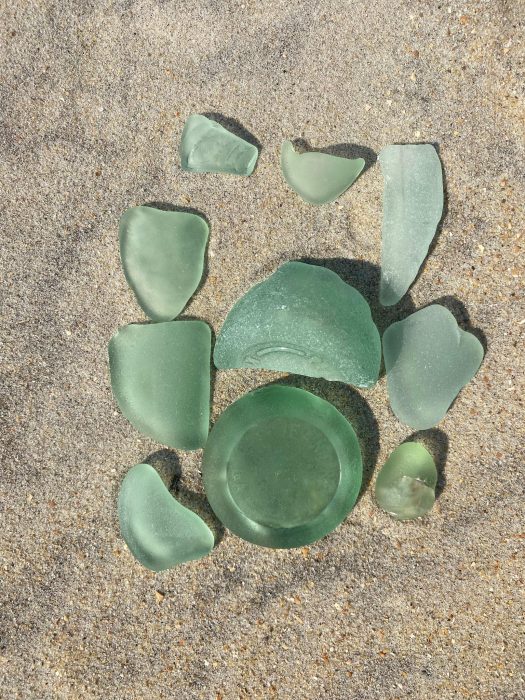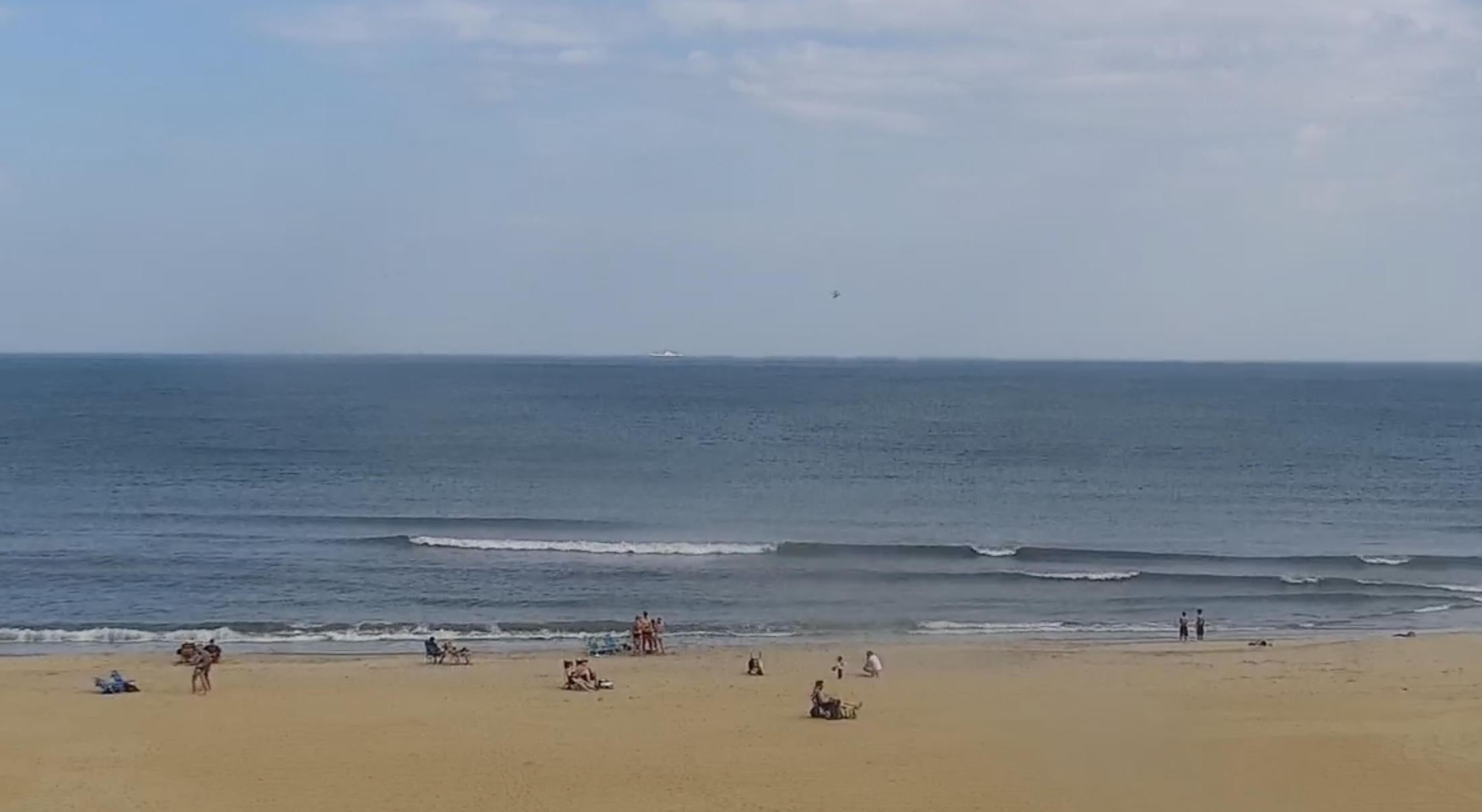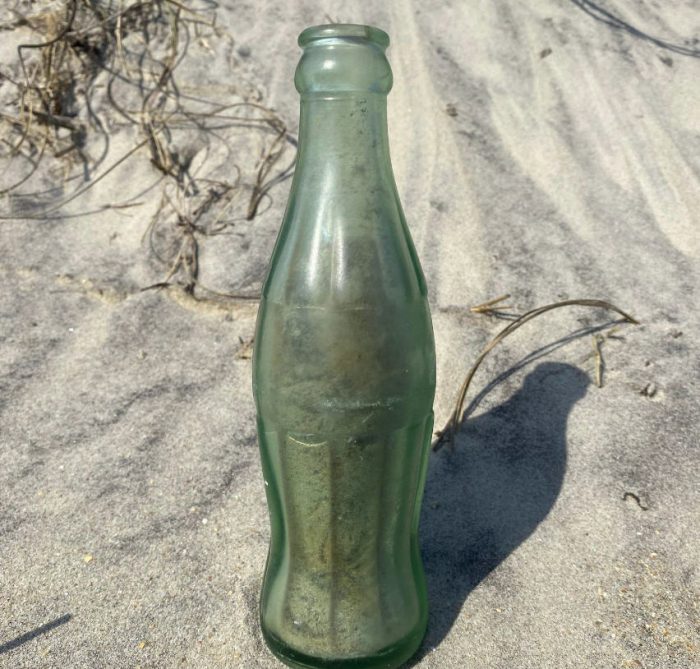
One of the most exciting aspects of beachcombing is never knowing what you can find on the sandy shores of the beach.
So many people ask me where to go in hopes that I know a secret location where they can easily find treasures, but the fact is that I have no way of ever knowing what treasures are waiting to be found. I do live on an island, so that makes the spots limited, but I like to switch up locations because I know the ocean is forever and constantly changing so nothing remains the same, especially on the shores of Hatteras Island.
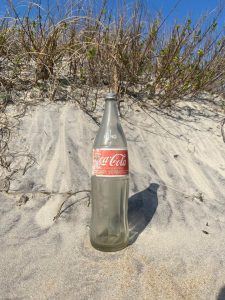
Not knowing what lies ahead is one of the lures that gets me up and out there searching, especially when looking for seaglass, because the colors of seaglass are endless and I love the whole spectrum.
One of my favorite colors to spot laying in the sand is the soft aqua green that comes from old Coca-Cola bottles. The contrast of the seafoam-green color of vintage coke bottles against the varying colors of the sand makes it pop, thus making it a little easier to spy when out searching for seaglass, compared to the most common clear or white seaglass pieces, which tend to blend into the surroundings.
Vintage Coke seaglass pieces are so fun to find for a variety of reasons.
Coca-Cola was a popular soda back then worldwide, (and still is today), thus making it possible for any bottle, manufactured from anywhere, to show up on some random beach.
One of my favorite finds is a completely intact Coca-Cola bottle that I discovered on the side of a tall sand dune. This bottle has its original aluminum screw cap and painted label still on it and the label is in Portuguese. It weighs about 2.15 lbs. and is 13.5” tall. It’s hard for me to determine how old it is, but based on everything I know and from all the glass bottles and plastic trash I’ve collected off the beach, I think it’s safe to say this bottle was made in the 1980s. This bottle is clear glass and not the brilliant seafoam green color the U.S. vintage coke bottles are made from, but the base of it is one of the thickest I’ve ever seen and the painted label is so unique.
I do have one aqua coke bottle which was buried in the sand on the sound side. At first, the sand inside the bottle was like concrete, but over time all the moisture evaporated from the inside, and the sand loosened up. The best part about this bottle is the bottom is stamped “Sandford NC” which identifies where it was manufactured.
Neither one of these bottles are “done” as far as seaglass collecting goes, but are useful in helping me identify shards of seaglass that could be pieces from Coca-Cola bottles. If no labels or markings exist on a piece of seaglass, then it’s virtually impossible to identify where it came from. Coke bottles have a very distinctive shape, one that is easily recognizable even without labeling. Only one of my aqua “Coke” seaglass pieces has “Coca” on it, but most have no markings at all. By using the two complete bottles, (mainly the aqua one), I have been able to identify other pieces of seaglass in my collection that are from coke bottles.
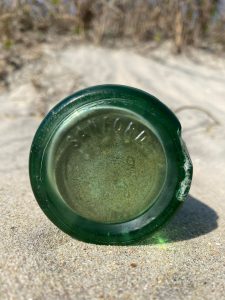
A bonus of living on the coast of North Carolina is that the birthplace of Pepsi-Cola, (New Bern, N.C.), isn’t too far from Hatteras, and there were several bottling plants on this side of the state. I met a man once who found a sun-dyed purple Pepsi glass bottle that was manufactured in Edenton. To me, as a seaglass collector, that means that the potential to find purple seaglass is high.
Knowing the history of the area and where people lived, slept, ate, and discarded their trash, is what provides the beach with seaglass. Historically on Hatteras Island and the Outer Banks, the villages of the past were small in population and the island is known more for its shipwrecks and wars fought along the shores than its “city life.” (Unlike, say, the shores of New York or New Jersey, where millions of people have lived for hundreds of years.) So seaglass beachcombers really want to search areas that have a history of civilization, or else you will come up empty-handed more often than not.
Even so, Hatteras Island can offer up some unique pieces of its own, and the only way to see if these treasures have washed ashore is to get out to the beach and start looking.
A note about glass and plastic bottles…
All this talk of beautiful coke seaglass makes my brain circle back to the idea that these are all things from the past that are diminishing quickly because glass bottles have been replaced by plastic. What if these corporations went back to glass bottles? If Coca-Cola started the movement, everyone would follow, and just imagine how much plastic would be saved from ending up the ocean. Check out this amazing article: https://wasteadvantagemag.com/its-time-for-glass-again-can-we-end-beverage-industrys-use-of-plastic/. Just something to think about when you are on your next beachcombing adventure and maybe get a little bummed that you didn’t find anything spectacular.
About the Author: Kristin Hissong is a North Carolina native, a UNC Charlotte graduate, an Outer Banks resident of nearly 20 years, and a dedicated, “professional beachcomber.” She has spent more than 20,000 hours walking on both our local shores and shorelines around the Eastern Seaboard, and has collected thousands upon thousands of items from the Atlantic Ocean.
For the past decades or so, she has been beachcombing on Hatteras and Ocracoke Islands every day, collecting both treasures and trash on her routine expeditions. From typewriters to coffee makers, fishing rods to recliners, if you name it, there’s a good chance she has seen it washed up, and has hauled it back to her collection, or to the closest dumpster.
